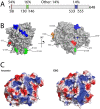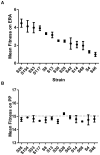Frequency and fitness consequences of bacteriophage φ6 host range mutations
- PMID: 25409341
- PMCID: PMC4237377
- DOI: 10.1371/journal.pone.0113078
Frequency and fitness consequences of bacteriophage φ6 host range mutations
Abstract
Viruses readily mutate and gain the ability to infect novel hosts, but few data are available regarding the number of possible host range-expanding mutations allowing infection of any given novel host, and the fitness consequences of these mutations on original and novel hosts. To gain insight into the process of host range expansion, we isolated and sequenced 69 independent mutants of the dsRNA bacteriophage Φ6 able to infect the novel host, Pseudomonas pseudoalcaligenes. In total, we found at least 17 unique suites of mutations among these 69 mutants. We assayed fitness for 13 of 17 mutant genotypes on P. pseudoalcaligenes and the standard laboratory host, P. phaseolicola. Mutants exhibited significantly lower fitnesses on P. pseudoalcaligenes compared to P. phaseolicola. Furthermore, 12 of the 13 assayed mutants showed reduced fitness on P. phaseolicola compared to wildtype Φ6, confirming the prevalence of antagonistic pleiotropy during host range expansion. Further experiments revealed that the mechanistic basis of these fitness differences was likely variation in host attachment ability. In addition, using computational protein modeling, we show that host-range expanding mutations occurred in hotspots on the surface of the phage's host attachment protein opposite a putative hydrophobic anchoring domain.
Conflict of interest statement
Figures



Similar articles
-
Pleiotropic costs of niche expansion in the RNA bacteriophage phi 6.Genetics. 2006 Feb;172(2):751-7. doi: 10.1534/genetics.105.051136. Epub 2005 Nov 19. Genetics. 2006. PMID: 16299384 Free PMC article.
-
Existing Host Range Mutations Constrain Further Emergence of RNA Viruses.J Virol. 2019 Feb 5;93(4):e01385-18. doi: 10.1128/JVI.01385-18. Print 2019 Feb 15. J Virol. 2019. PMID: 30463962 Free PMC article.
-
Competition and the origins of novelty: experimental evolution of niche-width expansion in a virus.Biol Lett. 2013 Feb 23;9(1):20120616. doi: 10.1098/rsbl.2012.0616. Epub 2012 Oct 17. Biol Lett. 2013. PMID: 23075527 Free PMC article.
-
Experimental Evolution Studies in Φ6 Cystovirus.Viruses. 2024 Jun 18;16(6):977. doi: 10.3390/v16060977. Viruses. 2024. PMID: 38932268 Free PMC article. Review.
-
Packaging, replication and recombination of the segmented genome of bacteriophage Phi6 and its relatives.Virus Res. 2004 Apr;101(1):83-92. doi: 10.1016/j.virusres.2003.12.008. Virus Res. 2004. PMID: 15010219 Review.
Cited by
-
Humidity Reduces Rapid and Distant Airborne Dispersal of Viable Viral Particles in Classroom Settings.Environ Sci Technol Lett. 2022 Jul 12;9(7):632-637. doi: 10.1021/acs.estlett.2c00243. Epub 2022 Jun 16. Environ Sci Technol Lett. 2022. PMID: 35937034 Free PMC article.
-
A virophage cross-species infection through mutant selection represses giant virus propagation, promoting host cell survival.Commun Biol. 2020 May 21;3(1):248. doi: 10.1038/s42003-020-0970-9. Commun Biol. 2020. PMID: 32439847 Free PMC article.
-
Interactions between bacterial and phage communities in natural environments.Nat Rev Microbiol. 2022 Jan;20(1):49-62. doi: 10.1038/s41579-021-00602-y. Epub 2021 Aug 9. Nat Rev Microbiol. 2022. PMID: 34373631 Review.
-
Risk of infection due to airborne virus in classroom environments lacking mechanical ventilation.PLoS One. 2024 Nov 22;19(11):e0314002. doi: 10.1371/journal.pone.0314002. eCollection 2024. PLoS One. 2024. PMID: 39576765 Free PMC article.
-
Adaptations of an RNA virus to increasing thermal stress.PLoS One. 2017 Dec 21;12(12):e0189602. doi: 10.1371/journal.pone.0189602. eCollection 2017. PLoS One. 2017. PMID: 29267297 Free PMC article.
References
-
- Christensen KLY, Holman RC, Steiner CA, Sejvar JJ, Stoll BJ, et al. (2009) Infectious disease hospitalizations in the United States. Clinical Infectious Diseases 49: 1025–1035. - PubMed
-
- Armstrong GL, Conn LA, Pinner RW (1999) Trends in infectious disease mortality in the United States during the 20th century. JAMA-Journal of the American Medical Association 281: 61–66. - PubMed
-
- Woolhouse M, Gaunt E (2007) Ecological origins of novel human pathogens. Critical Reviews in Microbiology 33: 231–242. - PubMed
Publication types
MeSH terms
Substances
LinkOut - more resources
Full Text Sources
Other Literature Sources

